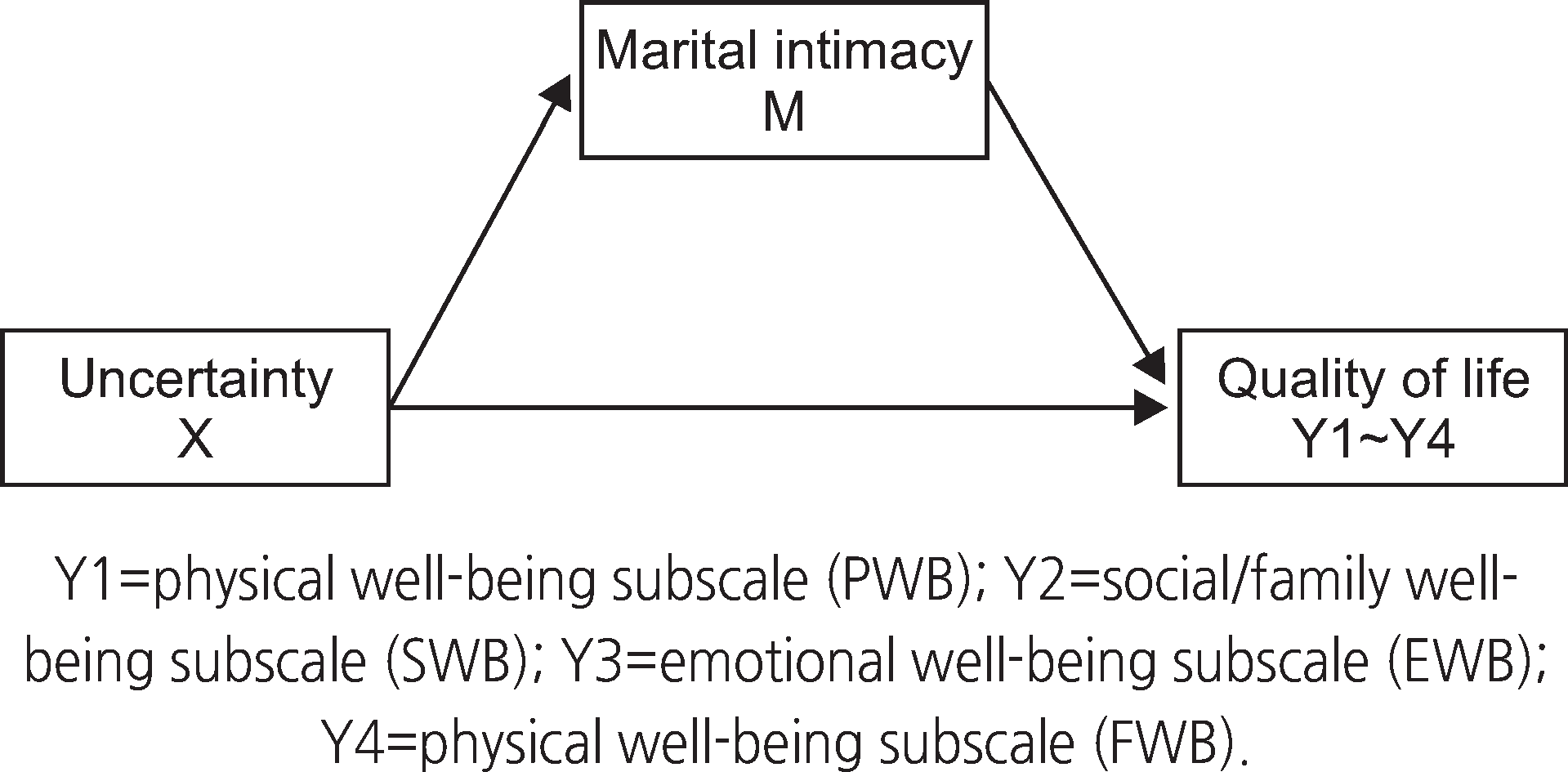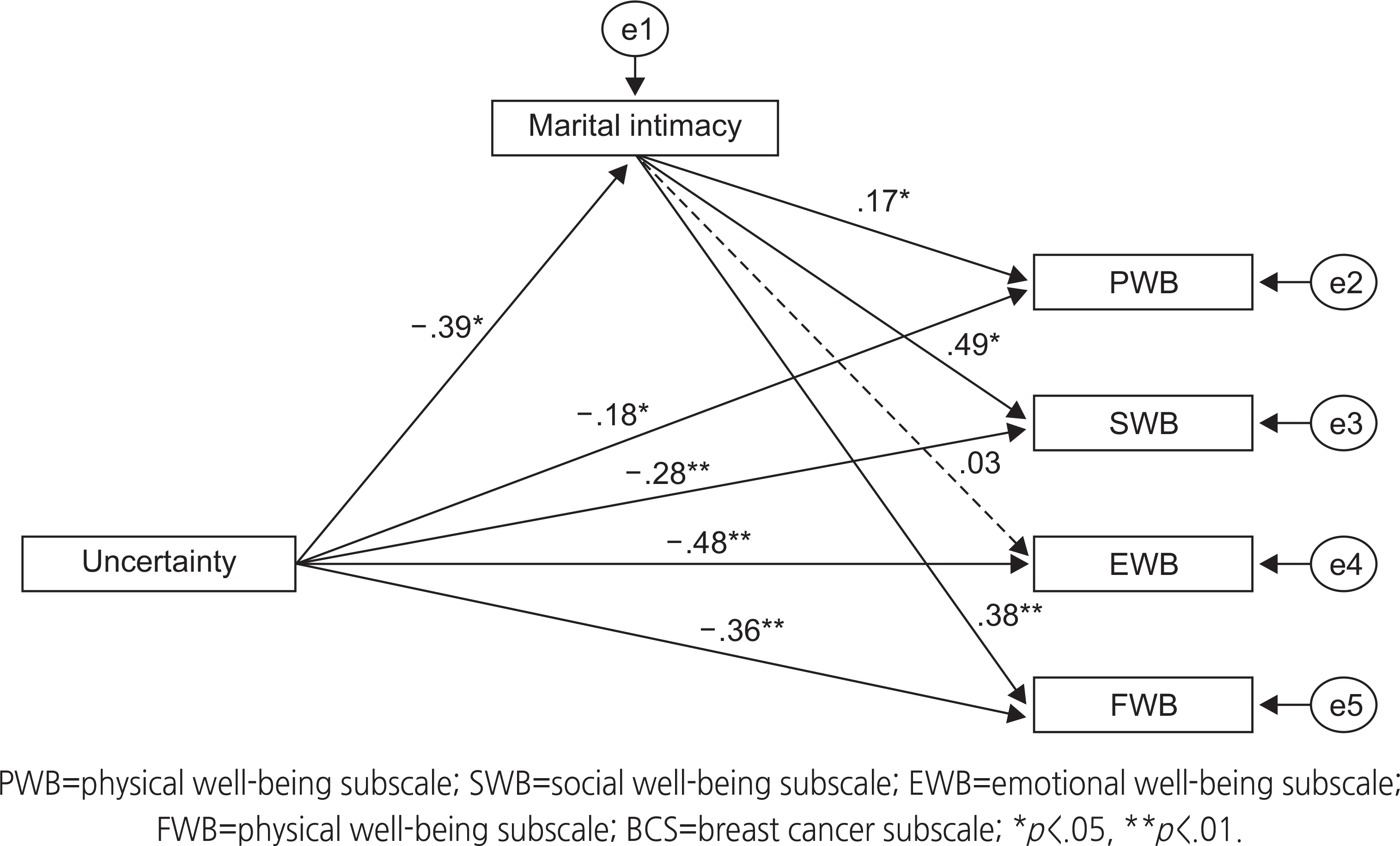Abstract
Purpose
The purpose of this study was to examine the mediating effect of marital intimacy on the impact of uncertainty on the quality of life (QoL) of young breast cancer patients.
Methods
This study used a pathway analysis with 154 young breast cancer cases in their early diagnosis stage at a medical center in Korea. Data were collected from November 2016 to February 2017 and analyzed using correlation analysis and pathway analysis.
Results
Uncertainty, marital intimacy, and 4 sub-scales of QoL showed a significant correlation. Marital intimacy was directly affected by uncertainty (b=-.39, p=.013) and 4 sub-scales of QoL were also affected by uncertainty. Among the 4 sub-scales of QoL, physical well-being (PWB) (b=.17, p=.026), social well-being (SWB) (b=.49, p=.010), and functional well-being (FWB) (b=.38, p=.009) were affected by marital intimacy but emotional well-being (EWB) was not affected by it. The mediating effect of marital intimacy on the impact of uncertainty on QoL was confirmed. Marital intimacy showed a significant indirect effect on PWB (b=-.07, p=.024), SWB (b=-.19, p=.008), and FWB (b=-.15, p=.005), and it means that marital intimacy has a partial mediating effect on the impact of uncertainty on PWB, SWB, and FWB.
References
1. National Cancer Information Center. Cancer by statistics [Internet]. Goyang: National Cancer Information Center;c2018. [cited 2018 Jan 24]. Available from:. https://www.cancer.go.kr/lay1/S1T639C643/contents.do.
2. Statistics Korea. KOSIS statistics [Internet]. Daejeon: Cancer by Statistics, Statistics Korea;c2018. [cited 2018 Jan 24]. Available from:. http://kosis.kr/statHtml/statHtml.do?orgId=117&tblId=DT_117N_A00023&conn_path=I2.
3. Syrowatka A, Motulsky A, Kurteva S, Hanley JA, Dixon WG, Meguerditchian AN, et al. Predictors of distress in female breast cancer survivors: A systematic review. Breast Cancer Research and Treatment. 2017; 165(2):229–245. https://doi.org/10.1007/s10549-017-4290-9.

4. Elmir R, Jackson D, Beale B, Schmied V. Against all odds: Australian women’s experiences of recovery from breast cancer. Journal of Clinical Nursing. 2010; 19(17‐18):2531–2538. https://doi.org/10.1111/j.1365-2702.2010.03196.x.

5. Stava CJ, Lopez A, Vassilopoulou-Sellin R. Health profiles of younger and older breast cancer survivors. Cancer. 2006; 107(8):1752–1759. https://doi.org/10.1002/cncr.22200.

6. Pahlevan Sharif SP. Locus of control, quality of life, anxiety, and depression among Malaysian breast cancer patients: The mediating role of uncertainty. European Journal of Oncology Nursing. 2017; 27:28–35. https://doi.org/10.1016/j.ejon.2017.01.005.

7. Kim J, Kim S, Lee H, Kim SH. The relationship among uncertainty, body image, social support and quality of life of young breast cancer survivors. Proceedings of Oncology Nursing Society 41st Annual Congress; 2016 Apr 28-May 1; San Antonio, TX. Pittsburgh (PA): Oncology Nursing Society;c2016. p. 137–138.
8. Kim HY, So HS. A structural model for psychosocial adjustment in patients with early breast cancer. Journal of Korean Academy of Nursing. 2012; 42(1):105–115. https://doi.org/10.4040/jkan.2012.42.1.105.

9. Mishel MH. Uncertainty in illness. Journal of Nursing Scholarship. 1988; 20(4):225–232. https://doi.org/10.1111/j.1547-5069.1988.tb00082.x.

10. Emmers TM, Canary DJ. The effect of uncertainty reducing strategies on young couples’ relational repair and intimacy. Communication Quarterly. 1996; 44(2):166–182. https://doi.org/10.1080/01463379609370008.

11. Knobloch LK, Knobloch FL. The role of relational uncertainty in depressive symptoms and relationship quality: An actor-partner interdependence model. Journal of Social & Personal Relationships. 2010; 27(1):137–159. https://doi.org/10.1177/0265407509348809.
12. Kimberley D. Living with uncertainty: The impact on breast cancer survivors and their intimate partners [dissertation]. Fort Lauderdale (FL): Nova Southeastern University;2014. p. 1–139.
13. Salakari M, Pylkkänen L, Sillanmäki L, Nurminen R, Rautava P, Koskenvuo M, et al. Social support and breast cancer: A comparatory study of breast cancer survivors, women with mental depression, women with hypertension and healthy female controls. Breast. 2017; 35:85–90. https://doi.org/10.1016/j.breast.2017.06.017.

14. Kroenke CH, Kubzansky LD, Schernhammer ES, Holmes MD, Kawachi I. Social networks, social support, and survival after breast cancer diagnosis. Journal of Clinical Oncology. 2006; 24(7):1105–1111. https://doi.org/10.1200/JCO.2005.04.2846.

15. Manne S, Badr H. Intimacy and relationship processes in cou-ples’psychosocial adaptation to cancer. Cancer. 2008; 112(11 Suppl):2541–2555. https://doi.org/10.1002/cncr.23450.
16. Keesing S, Rosenwax L, McNamara B. A dyadic approach to understanding the impact of breast cancer on relationships between partners during early survivorship. BMC Womens Health. 2016; 16:57. https://doi.org/10.1186/s12905-016-0337-z.

17. Moreira H, Canavarro MC. Psychosocial adjustment and marital intimacy among partners of patients with breast cancer: A comparison study with partners of healthy women. Journal of Psychosocial Oncology. 2013; 31(3):282–304. https://doi.org/10.1080/07347332.2013.778934.

18. Wimberly SR, Carver CS, Laurenceau JP, Harris SD, Antoni MH. Perceived partner reactions to diagnosis and treatment of breast cancer: Impact on psychosocial and psychosexual adjustment. Journal of Consulting and Clinical Psychology. 2005; 73(2):300–311. https://doi.org/10.1037/0022-006X.73.2.300.

19. Park JH, Bae SH, Lee EH. The influence of marital intimacy on mental health and quality of life in breast cancer survivors. Korean Journal of Health Promotion. 2010; 10(4):177–184.
20. Kwan ML, Ergas IJ, Somkin CP, Quesenberry CP Jr, Neugut AI, Hershman DL, et al. Quality of life among women recently diagnosed with invasive breast cancer: The pathways study. Breast Cancer Research and Treatment. 2010; 123(2):507–524. https://doi.org/10.1007/s10549-010-0764-8.

21. Korean Breast Cancer Society. 2017 Breast cancer facts & figures [Internet]. Seoul: Korean Breast Cancer Society;c2017. [cited 2017 Nov 11]. Available from:. http://www.kbcs.or.kr/sub02/sub04.html.
22. Stevens J. Applied multivariate statistics for the social sciences. 3rd ed. Mahwah (NJ): Lawrence Eribaum Associates;1996. p. 371.
23. Chung C, Kim MJ, Rhee MH, Do HG. Functional status and psychosocial adjustment in gynecologic cancer patients receiving chemotherapy. Korean Journal of Women Health Nursing. 2005; 11(1):58–66.

24. Waring EM, Reddon JR. The measurement of intimacy in marriage: The waring intimacy questionnaire. Journal of Clinical Psychology. 1983; 39(1):53–57. https://doi.org/10.1002/1097-4679(198301)39:1<53::AID-JCLP2270390110>3.0.CO;2-0.

25. Kim SN. A structural model for quality of life in women having hysterectomies. Journal of Korean Academy of Nursing. 1999; 29(1):161–173. https://doi.org/10.4040/jkan.1999.29.1.161.

26. Brady MJ, Cella DF, Mo F, Bonomi AE, Tulsky DS, Lloyd SR, et al. Reliability and validity of the Functional Assessment of Cancer Therapy-Breast quality-of-life instrument. Journal of Clinical Oncology. 1997; 15(3):974–986. https://doi.org10.1200/JCO.1997.15.3.974.

27. Park YJ. Uncertainty, anxiety, and social support among preoperative patients of cancer: A correlational study [master’s thesis]. Seoul: Seoul National University;2015. p. 1–63.
28. Yoo YS, Hwang KH, Cho OH. Conflict resolution styles, marital intimacy and family functions of breast cancer patients and their spouses. Korean Journal of Adult Nursing. 2013; 25(1):33–40. https://doi.org/10.7475/kjan.2013.25.1.33.

Table 1.
Subject Characteristics and Analysis of Differences in Uncertainty, Marital Intimacy and Quality of Life (N=154)




 PDF
PDF ePub
ePub Citation
Citation Print
Print




 XML Download
XML Download